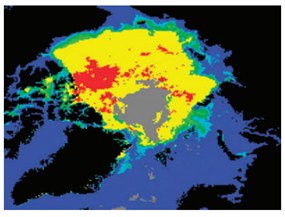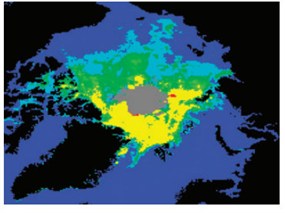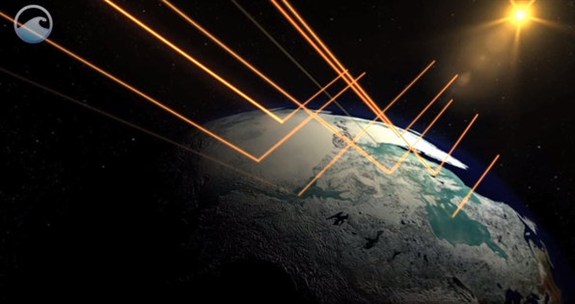Reflections on a changing Arctic: Less ice means faster warming
Posted on 9 August 2013 by dana1981
This is a re-post of a Carbon Brief article by Roz Pidcock
The Arctic is intricately linked to earth's climate. As Arctic sea ice declines, the effects are being felt far beyond the Arctic region. Now a new study shows how losing sea ice means the top of the planet is absorbing more heat than it did just three decades ago - and it makes for a sobering read.
Scientists have noticed big changes in the Arctic since satellites started observing earth from space, thirty years ago. The area covered by sea ice is getting smaller and the ice is getting thinner, due largely to rising global temperature.
The loss is most noticeable at the end of summer, when sea ice shrinks to a minimum, as part of its seasonal cycle. In September 2012, Arctic sea ice reached its lowest extent since satellite records began.
Knock-on effects
Losing sea ice has knock on effects for climate. One of the most direct consequences is that losing sea ice changes something scientists call albedo. Albedo is a measure of how well the earth's surface reflects sunlight.
Snow-covered sea ice has a high albedo, reflecting up to 85 per cent of sunlight. As the area covered by ice and snow gets smaller, sunlight that would have been reflected is absorbed by open water instead, warming it up.
The albedo effect in the Arctic. Source: NASA
It's not only the ocean that warms. Heat from the warmer sea is released back into the air - raising atmospheric temperatures too. In turn, this melts more ice. It's largely for this reason that the Arctic region is warming twice as fast as the rest of the planet.
To find out how much Arctic ice loss is likely to influence and be influenced by warming in the coming century, scientists need a good understanding of how albedo has changed in response to recent temperature changes.
This is exactly what new research, published today in Nature Climate Change, looks at. It examines how Arctic albedo has changed over almost three decades, between 1982 and 2009.
The team of scientists from Finland use new satellite measurements of reflectivity throughout the melt season, from May to August, to look for trends over time across the whole Arctic region.
Rapid decline
Every month except May has seen a decline in sea ice albedo over the 28-year period, the research finds. The exception didn't come as a surprise, say the researchers. Other studies have shown thick snow cover in May means the albedo doesn't change much.
The most rapid drop in albedo is seen in the month of August, when snow and ice melt is highest. The data suggests a fall in albedo of about three per cent per decade over the study period.
The loss is pretty clear in the satellite images below, which show albedo for the month of August in 1985 on the left and in 2008 on the right. Marked in red, areas with an albedo of 75 per cent or more have all but disappeared and have been replaced by green, which represents about 40 per cent. There is quite a lot more light blue, up to 30 per cent, and dark blue, which is 15 per cent and under.


Satellite images for August showing the shift from higher albedo (red) to lower albedo (blue) between 1985 (left) and 2008 (right). Source: Riihela et al., (2013)
Albedo is also affected by changes in the condition of the ice that remains. For example, ice is getting darker as industrial soot - known as black carbon - is finding its way into the Arctic.
Data from other studies suggest the rate of Arctic ice melt has accelerated since the 1990s, which might imply the rate of albedo loss has accelerated too. The new paper looks at this possibility but concludes there is too much year-to-year variability in this short time frame to come to any firm conclusions.
While albedo loss is most pronounced in August, the paper points out the drop in early summer is most important for global temperature, as that's typically when solar output is at its highest.
A warming Arctic has implications for the neighbouring Greenland ice sheet and Arctic wildlife - from the smallest algae to the biggest predators. On top of these more established impacts, scientists think sea ice loss might be disrupting winter weather in the northern hemisphere - another way that the impacts of change at the top of the planet might extend well beyond just the Arctic region.
Source: Riihelä et al., (2013) Observed changes in the albedo of the Arctic sea-ice zone for the period 1982 to 2009. Nature Climate Change, doi:10.1038/NCLIMATE1963































 Arguments
Arguments































Given albedo change numbers, the obvious next step is to integrate the function delta energy absorbed over the arctic during summer months (may thru september) and average the energy over the whole year and the global surface. It would be interesting to compare the resulting forcing with the existing imbalance of 0.6W/m2 and the delta forcing the human increase of 2ppm/y brings.
Has anyone done that? Which delta forcing would be higher? It would be interesting to predict arctic albedo delta forcing until 2100. Of course not on IPCC estimates (which we know are completely wrong in arctic with respect to any parameter) but e.g. on Maslowski's estimates which are right on track. I guess IPCC did not even take arctic albedo changes into their scenarios in AR5.
So, with delta albedo established at about -10% since satelite records, can anyone come with ballpark forcing figure I am asking?
Given everything that is stated in the article, it seems unlikely that a recovery is possible.
There is more CO2 in the atmosphere - so there is more TOA forcing,
There was less ice last year - so there should be less this year
This positive feedback loop is tantamount to a runaway heating loop - bounded only by the fact that once the ice is gone - its gone. Of all the postulated theories, this one seems the most likely to be tested the earliest. It seems likely that there will be some kind of a rebound (at least for this year) in the quantity of artic ice. The next few years will be very telling.
franklefki
Agree with what you say with one proviso. Year to year variability can swamp the trend briefly. But the long term trend, using a several year average for example, is clear cut.
This year in the Arctic is stunning. Stunningly strange. Huge cracking events through Feb-April, Significantly colder and cloudier this year. Several cyclones that have (are as I speak) smashing the thin ice up. The possibility of an ice free Pole this year, maybe an ice free Eastern Hemisphere. But much reduced ice loss in the Beaufort & Chukchi seas. Smoke from forest fires in Russia moving out over the arctic. Jet Stream doing weird stuff. Record highs in parts of northern Canada and Greenland. Then freezing the next day. The Kara sea taking forever to melt out. And ice transport out through the Fram Strait almost shut down.
Hold onto your hats.
Trends in Arctic sea ice loss are easier to spot when considering volume (as opposed to area or extent). See, for example, this:
http://iwantsomeproof.com/extimg/siv_annual_polar_graph.png
More here:
https://sites.google.com/site/pettitclimategraphs/
And I agree, Glenn - watching daily events/data coming from the Arctic this year has been nothing short of stunning.
Notably absent from this analysis and discussion is any mention whatsoever of Antarctic sea ice. One might easily get the impression that our planet has only one pole.
A more comprehensive view would consider global sea ice area, not just the northern hemisphere. And that perspective would show a somewhat different picture:
(-snip-)
(-snip-)
[DB] The topic of this thread is The Arctic, not the Antarctic. As others have helpfully noted for you, take your attempted discussion of things Antarctic to one of the more appropriate thread.
Further, please familiarize yourself with this site's Comments Policy before posting any further comments. Please also ensure that all future comments comply with the Comments Policy. Subsequent off-topic comments similar to this will be simply deleted.
Off-topic snipped.
Russ: Conditions in the arctic and antarctic are very different, so combining the data doesn't clarify what's going on, it obscures it. Antarctic sea ice is strictly a winter phenomenon, so its greater extent (apparently due to a strengthened antarctic gyre and possibly fresher surface water from increased melting of land ice) has no significant effect on albedo. Meanwhile, warmer, saltier subsurface water is undermining large glaciers.
In the arctic, on the other hand, the increased melt/ decreased area happens during summer and makes a big difference to albedo (even when ice extent remains high, meltwater on the surface reduces albedo). The trend there is running well ahead of models, and trying to make it 'go away' by combining it with antarctic sea ice measures is a fool's errand.
Russ, if you want to be taken seriously as someone who's interested in scientific progress, avoid doing what you have done. You accuse others of ignoring data, but you fail to point out why the data are meaningful. The same logic is used with "GMST trend is statistically significant over the last 15 years!" So what? No one talks about Antarctic sea ice. Why should they? I'm not saying it can't be relevant; I'm asking you to tell me why it is.
Ugh - "significant" > "insignificant"
Doh
Russ R.,
mbryson is right. Nothing wrong with a discussion of Antarctic Sea Ice, but once you get to the nitty-gritties, the Arctic is mainly ocean, Antarctica is mainly land ice.
Though I hope you are not arguing that there is some "compensatory" mechanism ensuring that Arctic + Antarctic Sea Ice is roughly constant. That is about the same as the "Jesus is just moving the ice from the Northern to the Southern Hemisphere" argument I have heard some deniers make.
Even a cursory look at your bottom chart shows that on a global scale, sea ice is declining, as is land ice and summer snowpack in the "cryosphere" generally.
This site has some good threads on Antarctic ice. The topic of this thread is the effect on albedo of Arctic ice decline, and the Arctic is indeed warming faster than anywhere on the planet.
www.skepticalscience.com/antarctica-gaining-ice-intermediate.htm
Russ wrote: "A more comprehensive view would consider global sea ice area..."
Ok. The third graph you posted shows global sea ice area... and a clearly declining trend.
Comprehensive view considered. Now back to the specifics of what is going on in the Arctic.
Russ@5,
I don't know what your "different picture of global ice" means because mod has snipped you (no doubt rightly so) but I agree the picture of antarctic ice is quite different. That's why this article about Arctic does not consider Antarctic, not because, as if, according to you, "the Earth had only one pole".
Other commenters already hinted the differences. I'd like to add, that the different response of antarctic ice is consistent with the global warming we are experiencing. Notably, the recent studies have linked the increased antarctic winter iceshelves with the decreased salinity of surface waters due to the melt of antarctic icesheet. So, that phenomenon should not be seen as a "sceptic"-proclaimed "recovery" but as another bad news, that we are loosing the antarctic icesheet - at increasing speed.
I've been pondering over the sea ice extent data recently. In particular I'm struck by the disparity between DMI's extent and that of JAXA, NSIDC, ROOS... in fact, *all* of the others.
As of 9th August, DMI indicates cover of 8.5 m/km^2; the others are around the 6.5 m/km^2.
I know that DMI use 30%, whereas most of the others use 15%; but then I'd have thought this would have made DMI extent smaller rather than larger than the others? Surely there are more cells with 15% ice than 30% ice?
And even accounting for the percentage difference, surely 2 m/km^2 is too large an extent difference to be explained by different counting methods?
Can anyone offer an explanation or tell me where I'm going wrong?
Thanks.
Chriskoz at 1. There was a post by Tamino 6 October analysing the forcing due to Arctic albedo changes
http://www.skepticalscience.com/arctic-antarctic-sea-ice-insolation.html
Here's an extract from the article -
In fact Hudson states that
"Results show that the globally and annually averaged radiative forcing caused by the observed loss of sea ice in the Arctic between 1979 and 2007 is approximately 0.1 W m-2"
Thank you for posting this fascinating article. The effects of reduced albedo, even at very high latitudes and hence low angle of incidence of the sun's rays , are obviously very important.
The other effect of reduced sea ice must be the reduction in insulation of the Arctic ocean water. Presumably open sea water must be able to release heat to the cold atmosphere, without the inhibiting effect of a blanket of ice covering it, more readily. Does anyone have any thoughts on this?
I recently watched Roy Spencer lie to congress ( a U. S. Senate committee) by stating that although sea ice was declining in the Arctic, it was increasing in the Antarctic and concluding that other testimony to the same committee on Arctic sea ice was only part of the story. It was Spencer who told only part of the story as he did not mention that the polar ice in the Antarctic is land based while that in the Arctic is sea ice (adjacent to Greenland which is land ice) and that all areas are losing ice as the planet warms. There is solid evidence that ice shelves tied to land ice in Antarctica are losing ice by being undercut by warming seas, therefure speeding Antarctic glaciers movement to the sea. Spencer's testimony was astoundingly simplistic, but not unexpected from such an "expert."
dwr, the DMI page states that it uses 15% sea ice extent. There is also a red note at the bottom which says they recently changed their methodology to adjust for coastal zones. A link in that red text goes to the version prior to the adjustment... which seems more in line with the other sources.
http://ocean.dmi.dk/arctic/icecover.uk.php
Thus, the higher ice extent DMI is showing compared to the other sources is apparently due to the fact that they are now measuring the ice extent over a larger total area.
If the sea releases heat into the atmosphere, this cools, not warms, the ocean. It also releases more water vapour into the atmosphere which can cause low pressure weater systems with accompanying clouds. This increases Albedo. This is clearly seen this year (2013) and while it will only delay the ultimate melt, it is interesting to see Gaia fighting back.
rockytom @15, whatever his other vices, Spencer cannot have lied simply by saying that Antarctic sea ice was increasing while Arctic sea ice was declining:
(Tamino)
Tamino had this to say in his most recent comment on Antarctic sea ice (of which I am aware):
(Original emphasis)
I don't have much to add to that except to note that the extended satellite record from 1973 shows a declining trend in Antarctic sea ice due to an initial sharp decline from 1973 to 1978 (PDF). Further, while Manabe et al (1991) predicted a thickening of Antarctic sea ice, and some more recent models (3 of 12 assessed by Stroeve et al (2007) also show a declining trend - the models are not consistent enough on this point to say that either increasing or decreasing Antarctic sea ice in the short term are prediction of climate science. Sea ice dynamics are not captured well in climate models either in the Arctic (where the decline is massively under predicted) nor the Antarctic (where the predictions are inconsistent between models).
Faster Warming Means Less Ice
BC@13,
Thanks for the pointer to the excellent post by Tamino, of which I am aware. Note that Tamino (as well as Hudson 2011 in large part) estimate the forcing from just the sea ice extent data. They model the resulting albedo change between sea ice and open ocean as 0.2 and calculate the resulting extra amount of isolation penetrating water. They asume no changes in other parameters. In particular, the type of ice and the clouds stay the same.
Riihela et al., (2013) however went beyond that, and have derived the albedo from satelite observations and shown that the type of ice has also changed, quote from the abrstract:
I don't have access to the full text so I am not sure if my understanding is correct, but I think their sea-ice zone albedo of −0.029±0.011/decade is just the result of change in quality of the remaining ice: i.e. ice becoming darker. Therefore, the resulting climate forcing should be calculated and added on top of Hudson/Tamino forcing. Having reread the former, ignoring the math, I do not feel the extra forcing from Riihela et al., (2013) will increase the perceived .1-.13W/m2. In any case, without unknown methane feedbacks, it is not signifficant (yet) compared to the primary CO2 forcing.
I guess "dark snow" project by Jason Box may shed additional light on the decreasing albedo in Arctic. So I'm looking for its results...
CBDunkerson: Thanks for the response.
I see that DMI states that its current 15% sea ice extent estimate "can differ slightly from other sea ice extent estimates".
Something of an understatement.